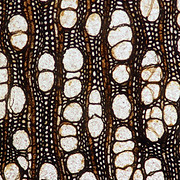REsearch
Current TOPICS

The diversification of flowering plants during the Cretaceous was among the most important transitions in the history of life on earth. How did they integrate with existing communities and transform the landscape? How did their diversification influence other plant and animal groups? Our research shows that fossils from the Cloverly Formation in Wyoming span the arrival of flowering plants in North America (Latest: D'Emic et al. 2019)

Fossil woods are a rich but underused source of information about ancient forests. What do fossil woods reveal about when angiosperm trees became part of the forest canopy? Our work on recently discovered fossils from Hornby Island and elsewhere are providing new insights on the structure and diversity of Cretaceous forests.

Fossil flowers, leaves, fruit, and wood are preserved in the Paleocene rocks of Patagonia, Argentina, just above the Cretaceous-Paleogene boundary. In collaboration with researchers from other institutions, we are investigating what these fossils reveal about the recovery from the end-Cretaceous extinction and the complex biogeographic history of Gondwana (Latest: Jud et al. 2020)

Neotropical forests in Central America host exceptionally high biodiversity, but the region has a poor fossil record. The recent expansion of the Panama Canal exposed Miocene rocks with abundant fossil woods and fruits. How has the diversity of plants in Panama changed since then? So far we have described several extinct species belonging to common modern genera, including forest trees and lianas (Latest: Jud et al. 2021).
Previous Work

The ETE working group gathered data from a variety of researchers (plants, mammals, fossil data, modern data) in order to look for patterns in species associations through time. Ecological data is often collected in the form of site by species matrices; we used a randomization technique to determine the proportion of species associations (e.g. co-occurrences) in the data that could not be attributed to chance. We showed that most of the fossil data matrices are dominated by species aggregations (i.e. species pairs that co-occur more often than expected by chance , whereas the Holocene and Recent data matrices were dominated by species segregations (i.e. species that never co-occur). We ruled out sampling effects and temporal extent of the data as possible causes of the pattern and determined that the shift in community structure is real. The shift coincides with the rise of human population and human influence on the environment. This suggests that not only have human activity has changed how biological communities are structured. See what we are up to now at the ETE website.

One of the most significant results of the Panama Canal Project was the discovery of fossilized monkey teeth from the lower Miocene. During the early Miocene, North and South America were separated by a seaway. Most of the vertebrates in Panama at that time also lived at higher latitudes in North America, but this was not so for monkeys. Why not? This observation is intriguing because the climate was warmer at that time and because similar age monkey fossils occur as far south as Argentina, indicating that neither climate nor dispersal ability limited monkey distribution. We described the new species Panamacebus transitus in Nature, and showed that a strong gradient in the composition of the flora of Central America limited the northern range of monkeys in North America during the Miocene.

Flowering plants make up more than 90% of land plant diversity, and more than 70% of flowering plants are eudicots. Early fossil evidence of eudicot angiosperms has been largely restricted to dispersed pollen grains, but reports of small, herbaceous early eudicots from Lower Cretaceous deposits are increasing. In the Bulletin of the Peabody Museum of Natural History, I reported a collection of plant fossils that includes a small early angiosperm with features of eudicot angiosperms. In Proceedings of the Royal Society B, I described the new species and showed that it was already known from other sites where it was misidentified as several different ferns. The plant, Fairlingtonia thyrsopteroides, was widespread in eastern North America ~115 Million years ago.

In the 1990s, phylogenetic using DNA sequence data clarified the relationships among living flowering plants, revealing that dicots are a paraphyletic group with monocots nested among them. The eudicots (true dicots) are a monophyletic group comprising more than 70% of angiosperm diversity today. Early fossils of the group are rare and many aspects of their evolution are unclear. I described a new genus and species of angiosperm with remarkable similarity to extant members of the fumitories. The leaf fossils were collected from the Aptian beds at Dutch Gap Canal in Virginia and they show the early occurrence of complex leaf architecture of a type particular to the eudicots. The morphology and small size of the fossils suggest that they were herbaceous plants, as is seen in other putative early eudicots. Potomacapnos apeleutheron, was named for the Freedmen who were conscripted by the Union army dig the Canal during the American Civil War and thereby exposed the site. This story was featured in American History Magazine, Civil War Magazine, Smithsonian magazine, and most thoroughly in TERP Magazine
Plant fossils in the Kansas City area date to the Late Pennsylvanian (~305 Ma). At that time Missouri was closer to the equator. During intervals of low sea-level, plants like Cordaites and Neuropteris colonized the coastal plain. Plant fossils collected near William Jewell College provide a snapshot of vegetation in the region during that time. Jewell Students are describing the diversity of plants from this site and comparing them with fossils from other regions and better understand the relationship between changing climate and vegetation during the Late Pennsylvanian.


